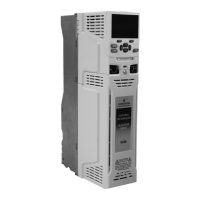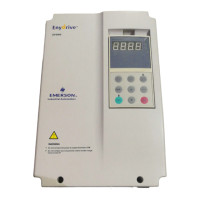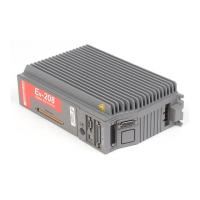Safety
information
Product
information
Mechanical
installation
Electrical
installation
Getting
started
User Menu A Commissioning
Advanced
Parameters
Diagnostics Optimization CT MODBUS RTU Technical Data
E300 Design Guide 347
Issue Number: 1
Final Current Loop Kp (J29) and Final Current Loop Ki (J30) are the proportional and integral gains of the current controllers. It is possible to use the
current controller in standard mode (Current Controller Mode (H17) = 0) or high performance mode (Current Controller Mode (H17) = 1). The set up
method for the current controller gains is described separately for each of these modes below. It should be noted that when an auto-tune is performed
that measures the Transient Inductance (B33) and Stator Resistance (B34) the Final Current Loop Kp (J29) and Final Current Loop Ki (J30) are
automatically set to the levels defined in the description for standard mode even if high performance mode is selected.
These gains will give good performance in standard mode and produce moderate acoustic noise due to position feedback quantisation with a
standard incremental encoder. These represent the maximum levels that are likely to be used with this mode in most applications. For high
performance mode it is recommended that a high resolution position feedback device is used or else the acoustic noise due to position feedback
quantisation is likely to be excessive. In high performance mode the proportional gain can be increased to a higher level as given in the description of
this mode.
Standard mode
Standard mode can be used to give good current control dynamic performance and is compatible with the performance of Unidrive SP. The current
controller gains can either be set using auto-tuning (see Motor Autotune (B11)) or the values can be set up manually by the user. The calculations
given below are those used by the auto-tuning system and should give good performance without excessive overshoot.
The proportional gain, Final Current Loop Kp (J29), is the most critical value in controlling the performance of the current controllers. The required
value can be calculated as
Final Current Loop Kp (J29) = (L / T) x (I
fs
/ V
fs
) x (256 / 5)
where:
T is the sample time of the current controllers. The drive compensates for any change of sample time, and so it should be assumed that the sample
time is equivalent to the base value of 167μs.
L is the motor inductance. For a servo motor this is half the phase to phase inductance that is normally specified by the manufacturer. For an induction
motor this is the per phase transient inductance (σLs). The inductance for either of these motors can be taken from the manufacturers data or it can
be obtained from the value stored in the Transient Inductance (B33) after auto-tuning.
I
fs
is the peak full scale current feedback, i.e. full scale current x √2. The r.m.s. full scale current is given by Drive Full Scale Current Kc (J06), and so
I
fs
= Drive Full Scale Current Kc (J06) x √2.
V
fs
is the maximum d.c. bus voltage.
Therefore:
Final Current Loop Kp (J29) = (L / 167μs) x (Kc x √2/ V
fs
) x (256 / 5) = K x L x Kc
Where K = [√2 / (V
fs
x 167μs)] x (256 / 5)
There is one value of the scaling factor K for each drive voltage rating as shown in the table below.
The integral gain, Final Current Loop Ki (J30), is less critical. A suggested value which matches the zero with the pole caused by the electrical time
constant of the motor and ensures that the integral term does not contribute to current overshoot is given by
Final Current Loop Ki (J30) = Final Current Loop Kp (J29) x 256 x T / τ
m
Where τ
m
is the motor time constant (L / R). R is the per phase stator resistance of the motor (i.e. half the resistance measured between two phases).
Therefore:
Final Current Loop Ki (J30) = (K x L x Kc) x 256 x 167μs x R / L = 0.0427 x K x R x Kc
The above equations give the gain values that should give a good response with minimal overshoot. If required the gains can be adjusted to modify
the performance as follows:
1. Final Current Loop Ki (J30) can be increased to improve the performance of the current controllers by reducing the effects of inverter non-
linearity. These effects become more significant with higher switching frequency. These effects will be more significant for drives with higher
current ratings and higher voltage ratings. If Final Current Loop Ki (J30) is increased by a factor of 4 it is possible to get up to 10% overshoot in
response to a step change of current reference. For high performance applications, it is recommended that Final Current Loop Ki (J30) is
increased by a factor of 4 from the auto-tuned values. As the inverter non-linearity is worse with higher switching frequencies it is may be
necessary to increase Final Current Loop Ki (J30) by a factor of 8 for operation with 16kHz switching frequency.
J29 Final Current Loop Kp
Mode RFC-A, RFC-S
Minimum 0 Maximum 30000
Default
Open-Loop: 20
RFC-A, RFC-S: 150
Units
Type 16 Bit User Save Update Rate Background read
Display Format Standard Decimal Places 0
Coding RW
Drive Rated Voltage (J07) Vfs K
200 V 415 V 1045
400 V 830 V 522
575 V 990 V 438
690 V 1190 V 364

